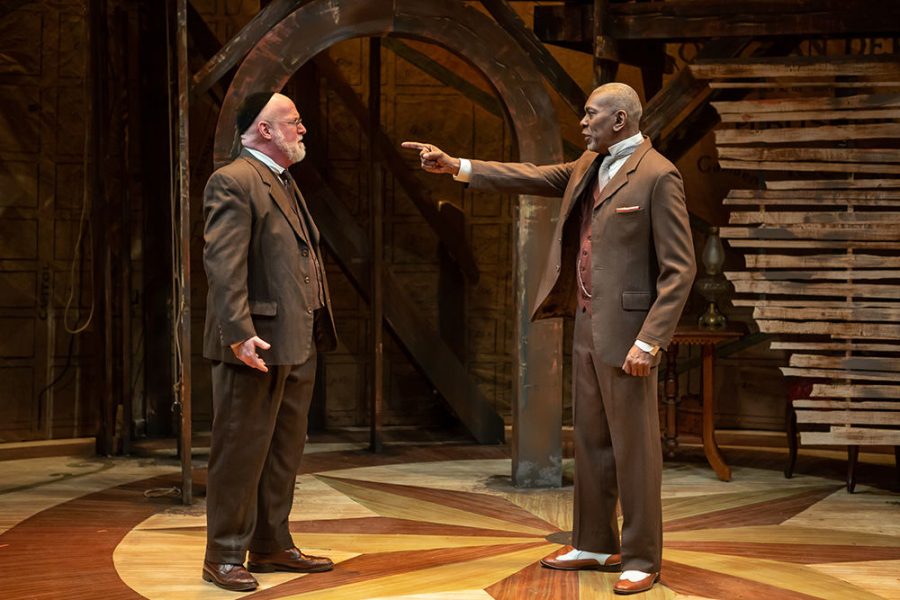At one time not long ago, it would have been unthinkable for a Jewish theater company to produce William Shakespeare’s “Merchant of Venice,” the lead character of which is Shylock, a bloodthirsty and corrupt moneylender in the fabled city during the Renaissance.
Shylock and Charles Dickens’ character Fagin in “Oliver Twist” have long been considered the vilest anti-Jewish characters in world literature. Over more recent years, both characters have been given more empathetic portrayals, and the original “Merchant of Venice” has been presented with Shylock as a less villainous presence.
Now, gifted playwright Aaron Posner has reimagined the Bard’s play, which was published in 1600, as “District Merchants,” and the New Jewish Theatre has brought it to robust life on the stage at the J.
ADVERTISEMENT
In Posner’s brilliant adaptation, both sides of the Shylock character are presented vividly in a superb performance by veteran actor/director Gary Wayne Barker. Barker’s Shylock, as envisioned by Posner, is a much more complicated character. He’s nobody’s fool, being steeped in Hebrew scripture and amusingly fluent in Yiddish sayings, a doting father to his overly protected daughter Jessica, as well as the harsh moneylender who demands a literal pound of flesh if his debtor does not repay his loan in full.
Posner subtitles “District Merchants” as “An Uneasy Comedy,” and the powerful script, a very strong cast and skillful direction by Jacqueline Thompson combine for a gripping evening of top-tier theater.
Posner has set the story of Shylock and his fellow characters in America during Reconstruction in the post-Civil War 1870s, when African Americans had been granted their freedom by the Emancipation Proclamation and the right to vote as full citizens.
ADVERTISEMENT
Like Venice during the Renaissance, Washington, D.C., was growing in wealth and power even though not all of the streets had yet been paved. Extreme poverty lived next door to extreme wealth. Racism, anti-Semitism and xenophobia, especially against Irish immigrants, were rampant. Influence peddling, financial corruption and an alternating boom and bust economy made living in the “District of Merchants” very challenging.
The characters in Posner’s version of “Merchant” largely parallel those in Shakespeare’s original version: As powerful and as complex as Shylock is, he has met his match in Antoine DuPre, a prosperous, thoughtful, shrewd and even merciless African-American merchant. Antoine is very proud of having been born free and resents being lumped together with former slaves. J. Samuel Davis infuses Antoine with a powerful intellectual as well as physical presence; he stalks the stage like a spirited lion.
Shylock’s beautiful and restless daughter Jessica, whom he smothers with overprotective parenting, is fully realized in the performance of Alicen Moser. Bursting under the corset of restrictions on her independence imposed by her father, Jessica longs to be free, even at great risk.
She finds herself romantically and physically attracted to Finn, a bold, engaging, Irish American who is generous and fun-loving and who himself the target of anti-Irish bigotry in late 19th century America. Paul Edwards nails this part with a perfect and endearing Irish accent and as a source of comfort for the anxious Jessica.
Portia (played with gusto by Courtney Bailey Parker) is the product of a wealthy family who has fallen in love with the study of law to the point where she dresses as a man to sneak into Harvard Law School as a student. She has a loyal, very smart and wise-beyond-her-years servant named Nessa (Rae Davis), whose wisecracks and feisty attitude liven up the action at key points and break the tension during some of the more harrowing scenes.
Shylock also has an African-American servant named Lancelot (Karl Hawkins), a multilayered character who is learned but naive about the harsh realities of the world and stays with Shylock even though he does not like him.
Shylock and Antoine have a love-hate relationship. At times, they admire each other; at others, they loathe each other. The scenes in which these two brilliant and highly opinionated characters share the stage provide some of the play’s greatest moments.
A shoutout goes to the production crew who help director Thompson achieve a gripping work that alternates between comedy and drama. David Blake’s scenic design is functional and visually impressive, providing a setting for the various interactions among the large number of characters.
Felia Davenport’s costume design is also spot on. Especially impressive is the three-piece suit worn by Antoine, which is impeccable from his pocket handkerchief down through his highly polished saddle shoes.
Posner has done Shakespeare and his most controversial play proud. Nearly every aspect of this production is pitch perfect. Even when parts of the second act seem long, the power of the script holds the audience in rapt attention.











